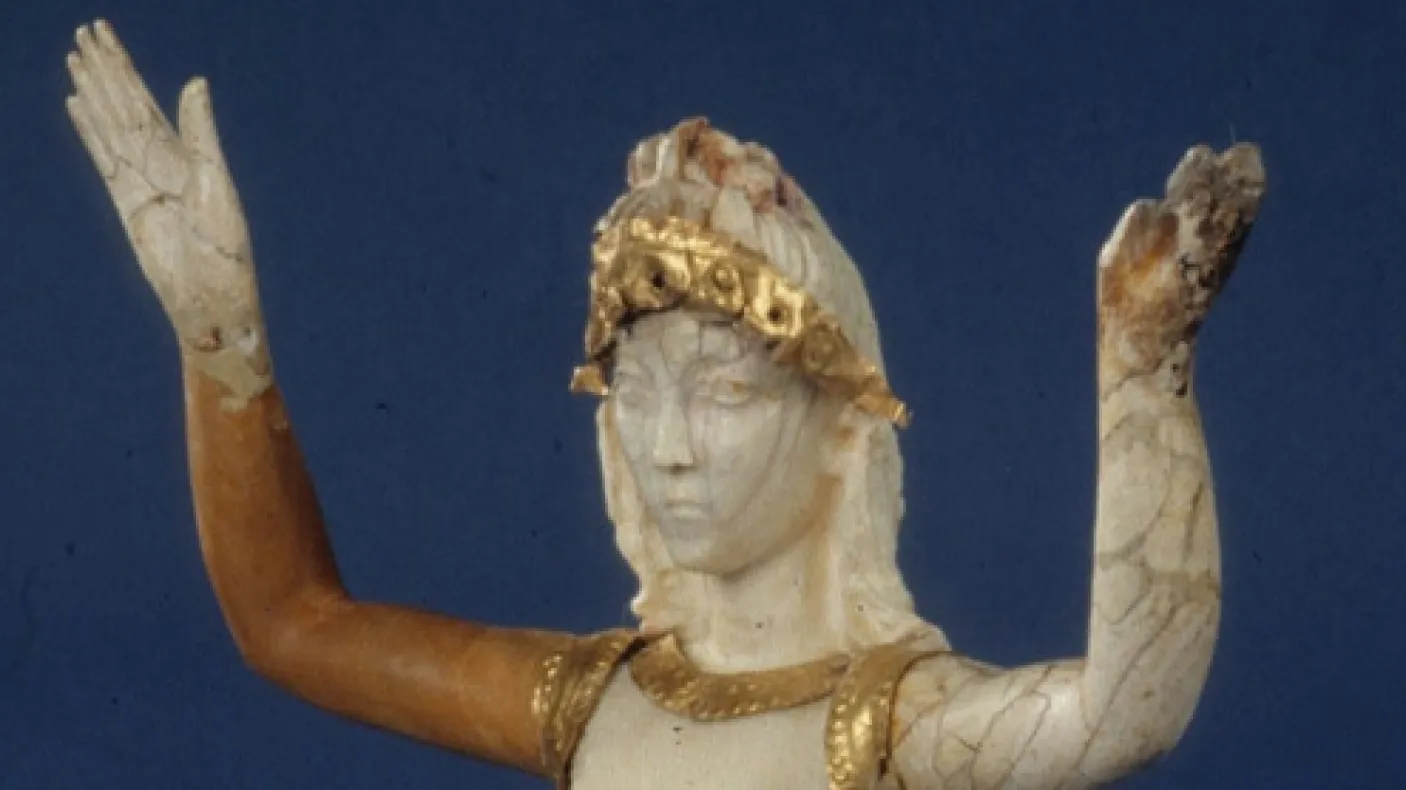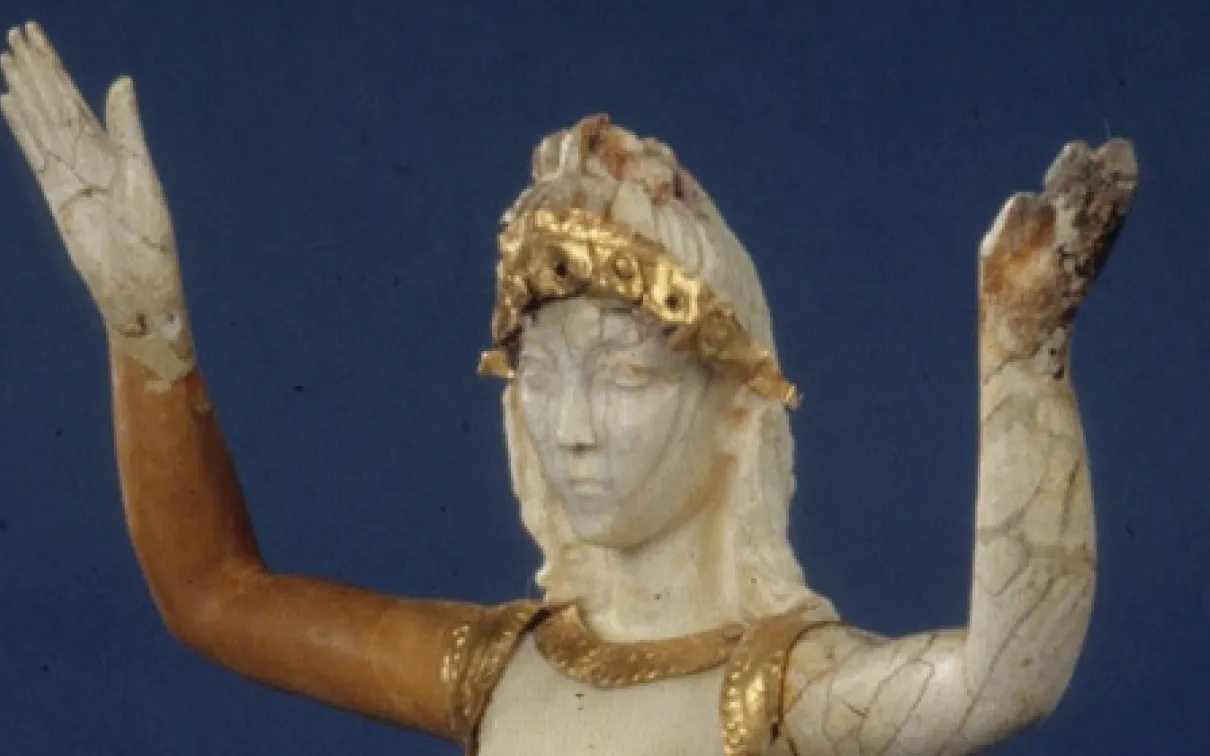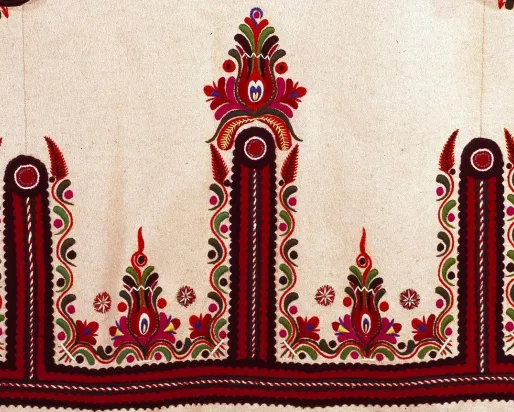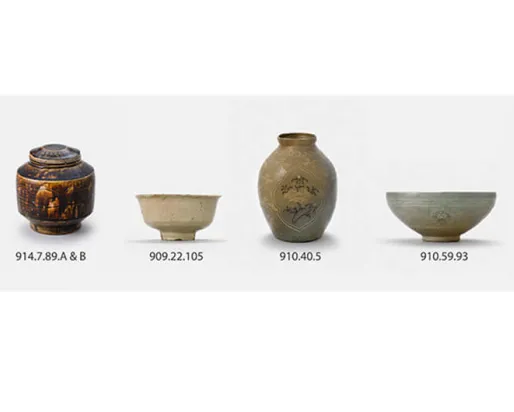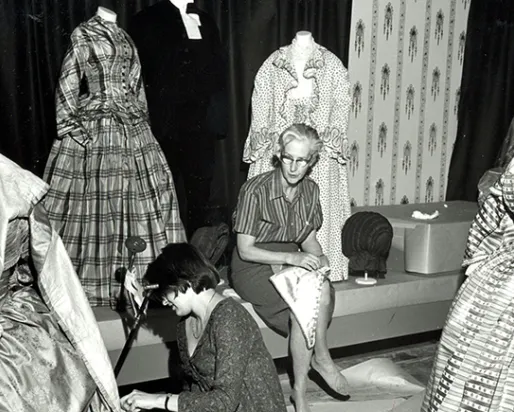Minoan Ivory Goddess
Categories
Researcher
About the Project
This exquisite ivory and gold (chryselephantine) figurine has been an icon of the Royal Ontario Museum (ROM) since she was acquired in 1931, but she has also attracted huge controversy.
When she was bought by the Museum, she was believed to be a rare example of a female bull-leaper from the Minoan civilisation of Bronze Age Crete, and dating to around 1600 BCE. She was an expensive prize for the recently-founded Museum and was much admired by experts. The most important of these was Sir Arthur Evans, who had himself discovered the remains of the Minoan civilisation at the beginning of the 20th century, and who named the ROM figurine “Our Lady of the Sports”. However, within less than a decade questions were raised as to her authenticity. With no certain archaeological findspot, and only a vague collection history before she came to the Museum, she was condemned by some scholars as a modern forgery, associated with several other `Minoan` figurines made of stone and ivory that appeared on the art market in the early decades of the 20th century. Other scholars defended her on technical grounds, comparing her to Bronze Age ivory fragments recovered from excavations on Crete.
For many years her fortunes wavered as scholarly opinion castigated and then rehabilitated her. She remained on display but was little publicised. Finally, a 2001 article in Archaeology magazine by Dr Kenneth Lapatin, a specialist in chryselephantine antiquities and now a curator at the J. Paul Getty Museum, reached the Canadian press and prompted a reassessment of the display. For the first time the doubts about her authenticity were voiced in the gallery label, and the museum visitor was invited to form their own opinion. In 2005, when the Bronze Age Aegean gallery re-opened after renovations, she was not included.
Throughout the long history and fluctuating fortunes of the goddess, there has been little actual investigative work, and what has been done has focussed on dating her to the Bronze Age. In 2013-2014 Kate Cooper, ROM Rebanks Postdoctoral Research Fellow in Greece & Rome, and Julia Fenn, ROM Conservator, started researching the goddess once again. This investigation aimed to examine the stories of the figurine herself, rather than proving a point. Standard scientific testing of the ivory is still not an option–it would be impossible to take a sample for a Carbon-14 test that hadn’t been contaminated by more recent conservation treatments without destroying the figure. But non-destructive examination of the figure and close study of the techniques of her manufacture can reveal more about how and when she was made.
Whenever she was made, she will enhance our understanding of the culture that created her. If she does come from Bronze Age Crete, she reveals the network of Minoan trading contacts that brought raw materials to Crete, and shows the skill of the ancient craftsmen that fashioned her. If she was made in the early 20th century, she has a story to tell about the craze for Minoan artefacts and Minoan-inspired fashions prompted by Sir Arthur Evans’ discovery of Knossos, and his ‘invention’ of the Minoan culture at the beginning of the century. Indeed, she embodies the way in which the ideas of a single expert, Evans himself, can influence the study and understanding of a period of history.
Closer to home, the goddess also speaks to the early history of ROM, showing how Charles Trick Currelly and his staff sought to establish the newly-formed Museum as a place of serious research and important collections, able to rival the older, better-known museums in America and Europe.
Here you can read more about the project:
Museum Attitudes
This research into ROM records and publications reveals the attitudes to the goddess throughout her time in the Museum–from her appearance on the art market in 1930 to the present day.
The Goddess in the Museum: the early years (August 6, 2013)
The Goddess in the Museum: the ROM reaction (August 7, 2013)
The Goddess in the Museum: “What’s in a name?” (August 9, 2013)
With thanks to Paul Denis (ROM Greek & Roman), Arthur Smith and Irene Wu (ROM Research Library), Nur Bahal (ROM Registration)
The Arthur Evans Connection
This examines the significance of Sir Arthur Evan’s discovery of the Minoan civilisation–how his interpretations were affected by his own agenda, and how the ancient Minoan culture affected the tastes and fashions of the early 20th century.
The Evans Connection Part 1: The Minoans Discovered (December 30, 2013)
The Evans Connection Part 2: The Minoans Created (December 31, 2013)
Meet the Family
The ROM goddess is often associated with other Minoan ivory figurines, now in museums around the world. Here I study examine these 'siblings' further. Some of them come from archaeological excavations and are certainly genuine, while others, without archaeological provenance, are often thought to be fake.
The ROM 'Minoan' Goddess: the Suspect Sisters (and brothers) (April 7, 2014)
The ROM 'Minoan' Goddess: The Minoan Relations (April 8, 2014)
With thanks for assistance and picture permissions to Kenneth Lapatin (J. Paul Getty Museum), Christine Kondoleon and Marta Fodor (Museum of Fine Arts, Boston), Marden Nichols and Ruth Bowler (Walters Art Museum, Baltimore), Sarah Berman and Matt Epsom (Seattle Art Museum), Amy Taylor (Ashmolean Museum), Yannis Galanakis (Cambridge University), Catherine Morgan and Amalia Kakissis (The British School at Athens).
A closer look
A short video lets you to look closely at the figurine, while Julia and I explain what you are seeing on the surface and what an x-ray of the goddess reveals.
Exposing the ROM 'Minoan' Goddess (November 6, 2013)
The Minoan Goddess Exposed (video)
With thanks to Zak Rogers, Scott Loane and Randy Dreager (ROM New Media), Heidi Sobol (ROM Conservation)
Let's talk about it
A virtual chat between Kate Cooper and Kenneth Lapatin, curator of Antiquities at the J. Paul Getty Museum in California, and author of Mysteries of the Snake Goddess. Art, desire and the forging of history (Boston 2002). It was Lapatin’s work that prompted the most recent controversy and re-investigation.
ROM Youtube video (February 12, 2014)
With thanks to Zak Rogers, Scott Loane and Randy Dreager (ROM New Media), Heidi Sobol (ROM Conservation)
The Goddess Revealed
The project culminated in a temporary exhibition that was part of ROM’s Centenary celebrations. From August 2014-2015 the ‘Minoan goddess’ figurine took centre stage in the Minoan Mystery or Modern Masterpiece multi-media display, which invited visitors to see for themselves the discoveries and questions that still remain unresolved.
With thanks to Julia Fenn (ROM Conservation), Paul Denis & Kay Sunahara (ROM DWC, Greek & Roman), Steven Laurie, Mary Montgomery, Bill Hodgkinson & Chloe Silver (ROM Project Management & Preparation), Cheryl Fraser & Alyssa McLeod (ROM Web), Randy Dreager (ROM Media Productions), Christine Caroppo & Dominique Picouet (ROM Interpretive Planning), Rae Ostman (former MD ROM Ancient Cultures), Dan Rahimi (former VP ROM Exhibitions & Programs)
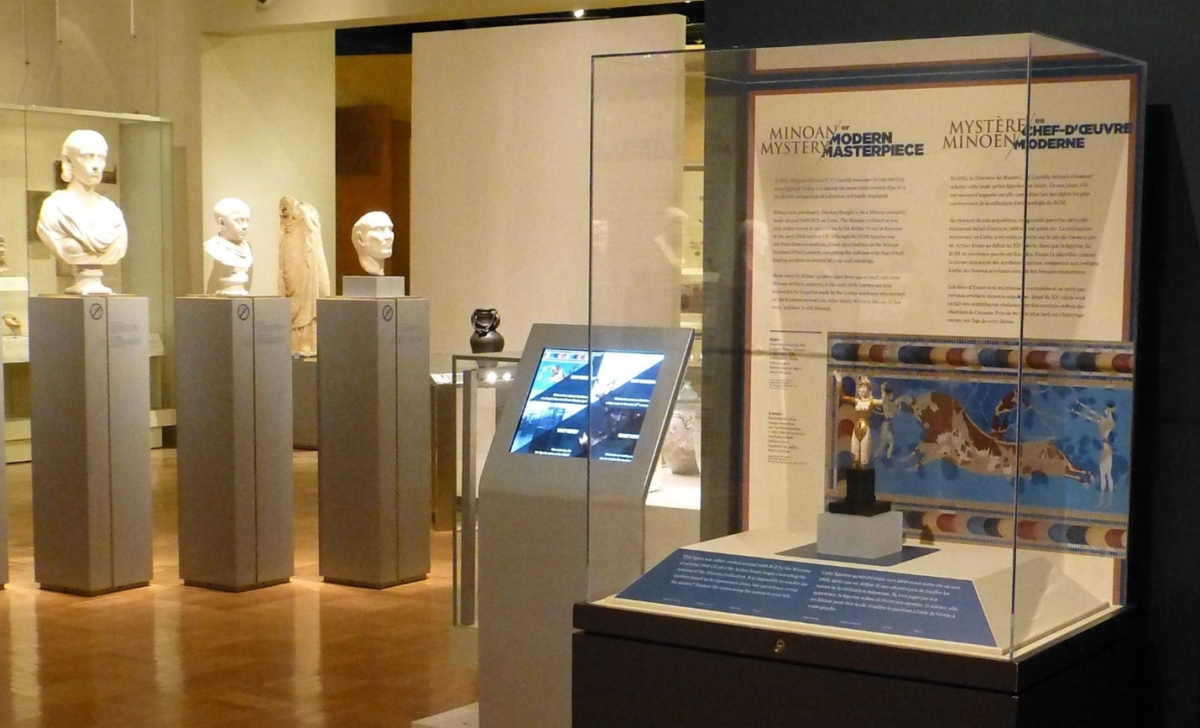
Photo: Kate Cooper


